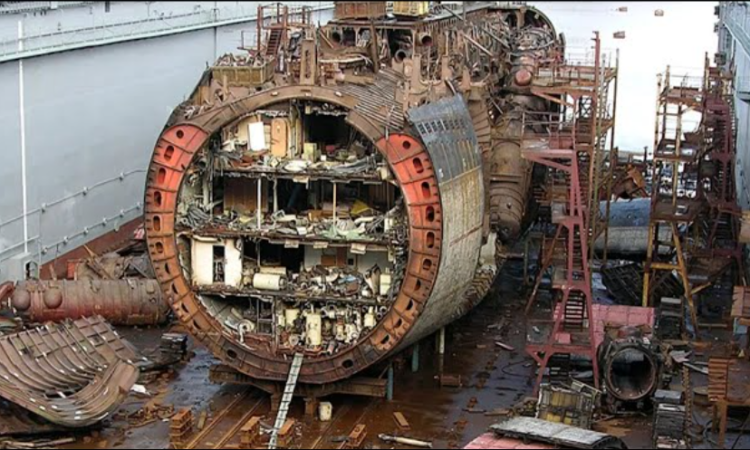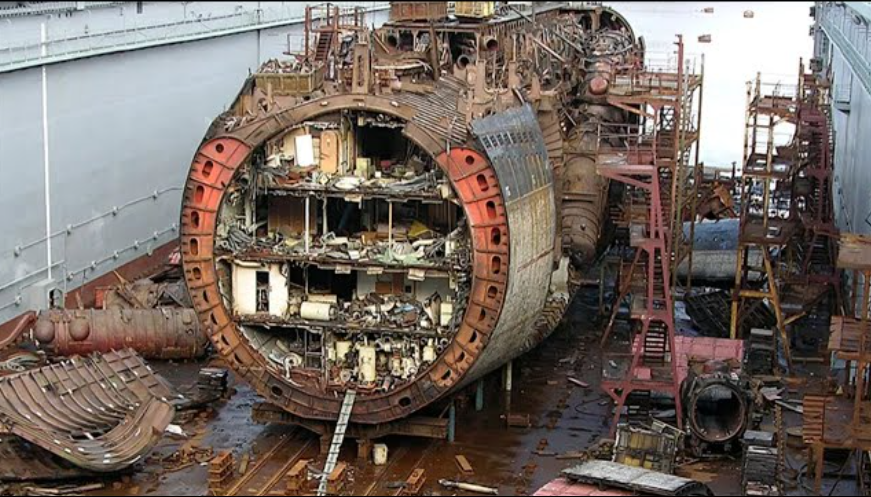
Nearly 80 years ago, a highly decorated World War II submarine mysteriously vanished into the depths of the Pacific Ocean. The USS Greyback, as she was known, was declared lost at sea on March 30th, 1944, after failing to arrive at Midway Atoll as scheduled.
For decades, it remained a mystery where her remains could possibly be. But in 2019, an organization known as The Lost 52 Project made an incredible discovery that changed what historians thought they knew about the Greyback. This is her story.

The United States officially entered World War II after the bombing of Pearl Harbor on December 7th, 1941. American citizens mobilized in any way they could, both domestically and internationally. By the end of the war, 50 million men of fighting age had registered for the draft, with 10 million of those having been inducted. Of those 10 million, 3 million served in the Navy. By the end of the war, the United States had the largest naval program in the world by far.
One of the most successful submarines during World War II was known as the USS Greyback. Under the command of Lieutenant Commander John Anderson Moore, the Greyback was a Tambor-class submarine, of which only 12 were ever built. A great success during her time in active patrol duty, the Greyback was ranked 20th of all American submarines in total tonnage sunk during World War II.
But despite all of her success, the USS Greyback was about to meet an unfortunate fate. Greyback’s keel was laid down by the Electric Boat Company in Connecticut. She measured a little over 300 ft from stern to stern and 27 ft at her widest point. Her maximum surface speed was 20 knots per hour, and she could stay submerged underwater for up to 48 hours when necessary.
Her range was 12,500 miles, and she had 10 21-inch torpedo tubes, six at the bow and four at the stern. Additionally, she carried a 50 caliber machine gun and around 20mm cannons on deck. The Greyback had an official crew strength of 54 enlisted men and six officers, although there were actually 80 men on board in total. The Greyback was launched on January 31st, 1940, and commissioned on June 30th, 1941, just five months before the United States officially entered the war.
In September 1941, she set off for the Caribbean on February 15th, 1942, she was ready for her first wartime patrol, cruising around Guam in the Western Pacific. Soon enough, she proved herself to be a highly effective tool for the Americans, sinking a Japanese cargo vessel that weighed 3,291 tons. The Greyback’s second patrol was to Freemantle in Australia, which ended up being the base for the rest of her service. Next, she headed to the East China Sea, and after several more patrols, the Greyback proved she was a force to be reckoned with, having sunk numerous enemy ships and submarines.
On her fifth tour of duty, on December 7th, 1942, she caught four landing barges, sinking them all. Despite all of her success, the Greyback was about to happen upon some very bad luck. On the morning of January 5th, 1943, the Greyback crew received word that six Americans had become stranded at Munda Bay in the Solomon Islands after a Martin B26 Marauder bomber crashed. In response, two men went ashore to find them, hid with them in the jungle from enemy aircraft, and successfully brought them to the Greyback. For this mission, Skipper Edward C. Stephan was awarded the Navy Cross and a Silver Star from the United States Army.
The Greyback embarked on her 10th war patrol on January 28th, 1944. This patrol ended up being her most successful yet in terms of tonnage sunk. On February 24th, the Greyback crew sent a message back to base that they’d successfully sunk the Japanese freighters Toshin Maru and Te Maru and hit an additional two. On February 25th, base received another message from the Greyback crew about a successful attack. But unfortunately, that message would be her last. Greyback’s final message stated that she had hit the Japanese liner Asama Maru and sunk the tanker Nansei Maru, making for more than 21,000 tons of Japanese shipping craft. These attacks left the Greyback with only two torpedoes, so she was ordered back to Midway Atoll to obtain more. By this point, she ranked 24th among all US submarines in the number of ships sunk, with 14.
It was clear by this point that the Greyback and her crew were destined to be celebrated as World War II heroes. Navy command expected the Greyback to arrive at Midway Atoll on March 7th, but all they got was complete radio silence. Even three weeks later, they still hadn’t heard anything about Greyback’s whereabouts. On March 30th, they were forced to make the difficult decision to declare the Greyback and her crew lost at sea. This was clearly a tragedy that no one had hoped for or foreseen. But things were about to get a lot more bizarre from there.
Based on captured Japanese records, here’s what likely happened to the Greyback in her final days. As the crew was heading back to Midway Atoll through the East China Sea, they used their last two torpedoes to sink the Sagon Maru on February 27th. On that same day, a Japanese aircraft carrier spotted the Greyback on the surface and attacked with a 500-lb aerial bomb. It was believed that the Greyback likely exploded and sank immediately.
For her service, the Greyback received numerous honors, including two Navy Unit Commendations. Decades before, researchers would get to the bottom of exactly what happened. The Lost 52 Project is a private organization that aims to find the remains of the 52 submarines that disappeared during World War II. Tragically, a total of 3,555 people were killed while on these submarines. Not only does the organization help to give the families of the lost crew members some closure, but they also work to survey the area of the wreckage and collect artifacts.
By some miracle, perhaps, the Lost 52 Project was about to discover something incredible. Founded by Tim Taylor, after he uncovered his first World War II submarine, the USS R-12, the project hits close to home for Taylor because his own father was a sailor during the war. Taylor had spent much of his life investigating the ocean, both for historic and scientific purposes. But it wasn’t until 2010 that he realized he wanted to hunt specifically for World War II wreckage sites. The USS R-12 was located on October 10th, 2010, near Key West, Florida. After locating the submarine, Taylor and his colleague Christine Dennison went on to produce a 24-minute documentary entitled “Expedition R12: Discovering America’s Forgotten Submarine.” From there on out, Taylor dedicated his life to finding the remaining missing submarines from World War II.
The team uses pioneering marine exploration methods, including remotely operated vehicles (ROVs) and imaging technology. In 2012 and 2014, respectively, the team set out on repeat expeditions to map and photograph the entire site of the R-12. One such pioneering mode of marine exploration is that of 4D modeling. The Lost 52 Project contributes to the development of technology that helps researchers view the full underwater wreckage site in its entirety. 4D modeling allows the team to snap individual images of the site and gather them into one image to zoom in and out with a high degree of accuracy. 4D modeling can also be used by marine biology researchers and students alike to fully map thermal vents or ocean ecosystems.
Helen Cashel Baldwin is one of the surviving family members of a crew member who perished with the USS R-12. Baldwin, who lost her father at the age of 8 in 1943, never received an official explanation for his disappearance. That is until she found out about Tim Taylor and the Lost 52 Project. Taylor arranged for Baldwin and her siblings to visit the site of the wreck, where they held a memorial and released 42 roses into the ocean in honor of the 42 men who had gone down with the submarine. “That was a completion of 70 years of waiting,” Baldwin said. “It was a life-changing experience.”
In 2014, the team discovered the USS S-26 in the Pacific Ocean off the coast of Panama. The S-26 was sunk by complete accident after it was mistaken for a German U-boat and rammed by the PC-460. Miraculously, the four men who were posted on the S-26’s bridge survived the submarine’s sinking. In 2018, 74 years after her disappearance, Taylor and his organization then set out to try and locate the USS Greyback and hopefully get some answers for the families of the lost men.
Ultimately, it was Utaka Iwasaki, the team’s Japanese historian and researcher, who discovered the missing link that would prove to be crucial in locating the Greyback. Iwasaki located and retranslated the original Japanese documents from Sasebo Base that indicated that the submarine had likely sunk about 100 miles southeast of Okinawa, Japan. However, he noticed an error. The error was small, but it remained uncorrected for more than five decades until the Lost 52 Project corrected it. The report in question had originally been radioed into Sasebo Base from Naha, Okinawa, a few days after the Greyback had reported back to base for the last time.
Iwasaki found that a single digit in a map reference had been transcribed incorrectly. The map gave the latitude and longitude of the attack on the Greyback. It turned out that the real coordinates of the wreckage were actually about 100 miles off from what the US Navy had originally thought. Now that they knew more precisely where the Greyback was laid to rest, the Lost 52 Project was able to locate it using ROVs and advanced imaging technology. On June 5th, 2019, they officially found the Greyback’s wreckage at a depth of 1,427 feet. The hull was found almost entirely in one piece.
But the expedition was far from easy or perfect. In fact, the team initially didn’t think they were going to find the Greyback at all. “It was amazing. The team had resigned to the fact that we were headed back to the port and would not complete the total search area this year,” said Taylor. “As the team was viewing the last bit of this data roll across the screen, you could feel everyone shuffling and getting ready to shift gears to secure the ship for getting underway. The next thing we see in the last quarter of the last line of data is the USS Greyback roll across the monitor.” The team couldn’t have been more excited about the discovery. But there was one thing they just couldn’t shake about the whole operation. “We were elated, but it’s also sobering because we just found 80 men,” Tim Taylor told The New York Times after the incredible discovery.
Next, the Lost 52 Project worked to inform the families of the Greyback’s crew that the resting place of their loved ones had finally been found. The families were surely saddened by the Greyback’s fate, but also relieved that they could now have some official closure and rest easy knowing exactly what had happened. For his work with the Lost 52 Project, Tim Taylor was given the Navy Distinguished Public Service Award by retired Rear Admiral and Director of Naval History and Heritage Command Sam Cox. “Every one of these lost submarines, along with our other ships, to the US Navy, is a hallowed site,” said Cox. “It’s a last resting place of sailors who made the ultimate sacrifice in the service of our country.
And in effect, it’s the Arlington National Cemetery for the Navy. Each discovery of a sunken craft is an opportunity to remember and honor the service of our sailors,” said Robert S. Neyland, PhD, Naval History and Heritage Command’s Underwater Archaeology Branch Head. “Knowing their final resting place brings closure in some part to their families and shipmates, as well as enables our team to better understand the circumstances in which the boat was lost. We’re grateful for the respectful, non-intrusive work Tim Taylor’s team performs and the opportunity they provide to remember and honor our history.”
As she pulled the clothes out of her daughter’s laundry basket, Faith was sick with worry. Even though she knew something was wrong, she had no idea how bad it could get. Mela, her daughter, had been going over to her neighbor’s house, so she had become distant and secretive.




